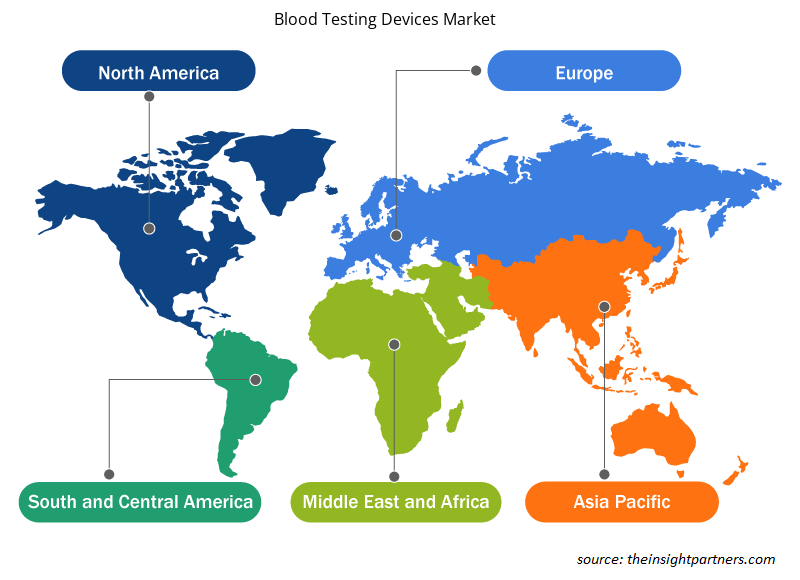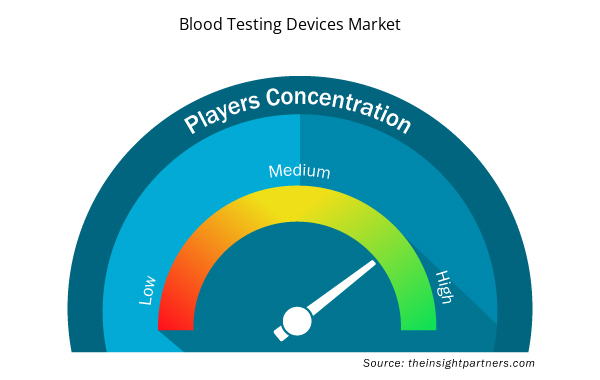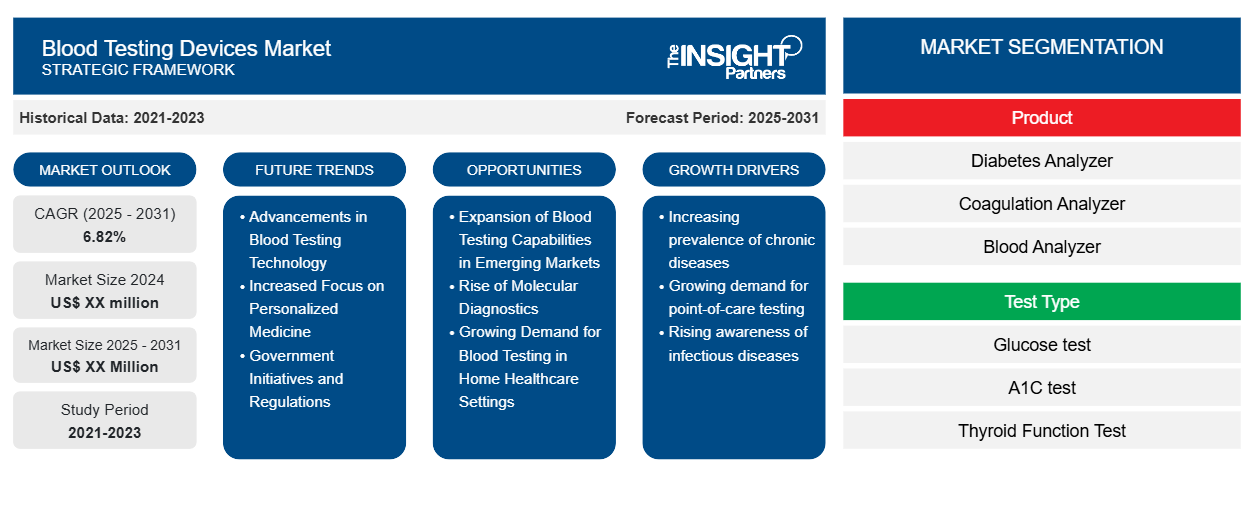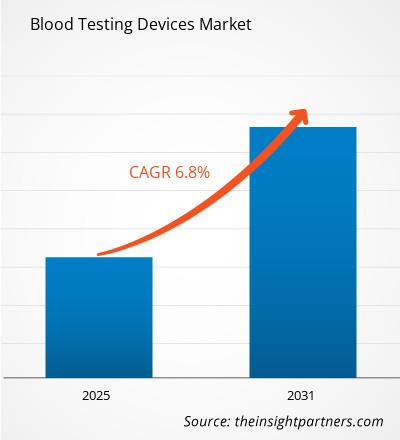Si prevede che il mercato dei dispositivi per analisi del sangue registrerà un CAGR del 6,82% dal 2023 al 2031, con una dimensione di mercato in espansione da XX milioni di dollari nel 2023 a XX milioni di dollari entro il 2031.
Il report è suddiviso in base a Prodotto (analizzatore per diabete, analizzatore per coagulazione, analizzatore del sangue e analizzatore ematologico), Tipo di test (test del glucosio, test A1C, test della funzionalità tiroidea, test della creatinina, test della coagulazione, emocromo completo, test LDL diretto e altri) e Utente finale (ospedali e cliniche, centri diagnostici e assistenza domiciliare). L'analisi globale è ulteriormente suddivisa a livello regionale e nei principali paesi. Il report offre il valore in USD per l'analisi e i segmenti di cui sopra.
Scopo del rapporto
Il report Blood Testing Devices Market di The Insight Partners mira a descrivere il panorama attuale e la crescita futura, i principali fattori trainanti, le sfide e le opportunità. Ciò fornirà spunti a vari stakeholder aziendali, come:
- Fornitori/produttori di tecnologia: per comprendere le dinamiche di mercato in evoluzione e conoscere le potenziali opportunità di crescita, consentendo loro di prendere decisioni strategiche informate.
- Investitori: condurre un'analisi completa delle tendenze in merito al tasso di crescita del mercato, alle proiezioni finanziarie del mercato e alle opportunità esistenti lungo la catena del valore.
- Enti di regolamentazione: regolamentano le politiche e le attività di controllo sul mercato allo scopo di ridurre al minimo gli abusi, preservare la fiducia degli investitori e sostenere l'integrità e la stabilità del mercato.
Segmentazione del mercato dei dispositivi per analisi del sangue
Prodotto
- Analizzatore del diabete
- Analizzatore di coagulazione
- Analizzatore del sangue
- Analizzatore ematologico
Tipo di prova
- Test del glucosio
- Test A1C
- Test della funzionalità tiroidea
- Test della creatinina
- Test di coagulazione
- Emocromo completo
- Test LDL diretto
- Altri
Utente finale
- Ospedali e cliniche
- Centri Diagnostici
- Assistenza domiciliare
Geografia
- America del Nord
- Europa
- Asia-Pacifico
- America del Sud e Centro
- Medio Oriente e Africa
Geografia
- America del Nord
- Europa
- Asia-Pacifico
- America del Sud e Centro
- Medio Oriente e Africa
Personalizza questo report in base alle tue esigenze
Riceverai la personalizzazione gratuita di qualsiasi report, comprese parti di questo report, o analisi a livello nazionale, pacchetto dati Excel, oltre a usufruire di grandi offerte e sconti per start-up e università
- Scopri le principali tendenze di mercato in questo rapporto.Questo campione GRATUITO includerà analisi di dati che spaziano dalle tendenze di mercato alle stime e alle previsioni.
Fattori trainanti della crescita del mercato dei dispositivi per analisi del sangue
- Aumento della prevalenza di malattie croniche: negli ultimi 25 anni, l'incidenza di malattie croniche è aumentata in tutto il mondo a causa dei cambiamenti nello stile di vita, che hanno portato a un aumento del numero di interventi chirurgici. Ad esempio, il cancro del colon-retto è uno dei tumori più comuni e letali sviluppati negli individui a causa dell'influenza combinata di fattori genetici e ambientali. Secondo l'Organizzazione mondiale della sanità (OMS), il cancro del colon-retto è stato identificato come il terzo tumore più comune e il secondo tumore più mortale, con circa 1.926.425 casi globali nel 2022. La prevalenza di malattie croniche come diabete, cancro e malattie cardiovascolari è in aumento a livello globale, portando a una crescente necessità di test diagnostici.
- Domanda crescente di test point-of-care: i dispositivi per test point-of-care (POCT) consentono ai medici o agli operatori sanitari di somministrare test a casa del paziente o presso uno studio medico diverso da un laboratorio, limitando quindi i test di laboratorio esterni e migliorando l'erogazione del servizio al paziente. La causa principale di questa tendenza è dovuta anche al progresso di tecnologie come la microfluidica, la nanotecnologia e i sistemi lab-on-a-chip. Queste tecnologie consentono apparati di test più piccoli e avanzati che non sono solo portatili, ma possono essere utilizzati da ogni individuo senza troppe difficoltà.
- Crescente consapevolezza delle malattie infettive: la crescente consapevolezza delle malattie infettive ha creato una maggiore necessità di dispositivi per analisi del sangue in grado di rilevare e diagnosticare queste malattie in modo rapido e accurato. Le dinamiche di trasmissione di malattie infettive come l'HIV e l'epatite hanno aumentato la domanda di dispositivi per analisi del sangue in grado di fornire una diagnosi rapida e accurata di queste malattie.
Tendenze future del mercato dei dispositivi per analisi del sangue
- Progressi nella tecnologia delle analisi del sangue: i progressi nella tecnologia delle analisi del sangue, come la miniaturizzazione, l'automazione e la digitalizzazione, stanno consentendo risultati più rapidi e accurati. Questi progressi stanno anche riducendo il costo dei dispositivi per le analisi del sangue, rendendoli più accessibili a una gamma più ampia di operatori sanitari e pazienti
- Maggiore attenzione alla medicina personalizzata: la crescente attenzione alla medicina personalizzata sta guidando la domanda di dispositivi per analisi del sangue in grado di fornire informazioni dettagliate sul profilo genetico e sullo stato di salute di un individuo. I dispositivi per analisi del sangue possono aiutare a identificare i marcatori genetici associati a determinate malattie, consentendo agli operatori sanitari di sviluppare piani di trattamento mirati
- Iniziative e normative governative: iniziative e normative governative volte a migliorare i risultati sanitari e a ridurre i costi sanitari stanno guidando la domanda di dispositivi per analisi del sangue. Ad esempio, i Centers for Medicare & Medicaid Services (CMS) hanno implementato nuove politiche di rimborso per i dispositivi di analisi POC, rendendoli più accessibili agli operatori sanitari.
Opportunità di mercato per i dispositivi di analisi del sangue
- Espansione delle capacità di analisi del sangue nei mercati emergenti: con lo sviluppo delle infrastrutture sanitarie nei mercati emergenti, cresce la domanda di dispositivi per analisi del sangue in grado di diagnosticare e monitorare una serie di malattie, tra cui malattie infettive e cancro.
- Ascesa della diagnostica molecolare: lo sviluppo di tecnologie di diagnostica molecolare, come la PCR (reazione a catena della polimerasi) e i test basati sulla PCR, potrebbe consentire un rilevamento più accurato e sensibile di malattie genetiche e agenti infettivi. Inoltre, si prevede che i crescenti investimenti da parte di governi e attori pubblici nella diagnostica molecolare aumenteranno le opportunità di collaborazioni e alleanze
- Crescente domanda di analisi del sangue in contesti di assistenza sanitaria domiciliare: la crescente tendenza verso l'assistenza sanitaria domiciliare e il monitoraggio remoto dei pazienti potrebbe aumentare la domanda di dispositivi portatili e facili da usare per le analisi del sangue, che possano essere utilizzati nelle abitazioni dei pazienti.
Approfondimenti regionali sul mercato dei dispositivi per analisi del sangue
Le tendenze regionali e i fattori che influenzano il mercato dei dispositivi per analisi del sangue durante il periodo di previsione sono stati ampiamente spiegati dagli analisti di Insight Partners. Questa sezione discute anche i segmenti e la geografia del mercato dei dispositivi per analisi del sangue in Nord America, Europa, Asia Pacifico, Medio Oriente e Africa e America meridionale e centrale.

- Ottieni i dati specifici regionali per il mercato dei dispositivi per analisi del sangue
Ambito del rapporto di mercato sui dispositivi per analisi del sangue
| Attributo del report | Dettagli |
|---|---|
| Dimensioni del mercato nel 2023 | XX milioni di dollari USA |
| Dimensioni del mercato entro il 2031 | XX milioni di dollari USA |
| CAGR globale (2023-2031) | 6,82% |
| Dati storici | 2021-2022 |
| Periodo di previsione | 2024-2031 |
| Segmenti coperti | Per Prodotto
|
| Regioni e Paesi coperti | America del Nord
|
| Leader di mercato e profili aziendali chiave |
|
Densità dei player del mercato dei dispositivi per analisi del sangue: comprendere il suo impatto sulle dinamiche aziendali
Il mercato dei dispositivi per analisi del sangue sta crescendo rapidamente, spinto dalla crescente domanda degli utenti finali dovuta a fattori quali l'evoluzione delle preferenze dei consumatori, i progressi tecnologici e una maggiore consapevolezza dei benefici del prodotto. Con l'aumento della domanda, le aziende stanno ampliando le loro offerte, innovando per soddisfare le esigenze dei consumatori e capitalizzando sulle tendenze emergenti, il che alimenta ulteriormente la crescita del mercato.
La densità degli operatori di mercato si riferisce alla distribuzione di aziende o società che operano in un particolare mercato o settore. Indica quanti concorrenti (operatori di mercato) sono presenti in un dato spazio di mercato in relazione alle sue dimensioni o al valore di mercato totale.
Le principali aziende che operano nel mercato dei dispositivi per analisi del sangue sono:
- Abate
- Laboratori Bio-Rad Inc.
- F. Hoffmann-La Roche Ltd
- Siemens AG
- Società anonima Trinity Biotech Plc.
Disclaimer : le aziende elencate sopra non sono classificate secondo un ordine particolare.

- Ottieni una panoramica dei principali attori del mercato dei dispositivi per analisi del sangue
Punti chiave di vendita
- Copertura completa: il rapporto copre in modo completo l'analisi di prodotti, servizi, tipologie e utenti finali del mercato dei dispositivi per analisi del sangue, fornendo una panoramica olistica.
- Analisi degli esperti: il rapporto è compilato sulla base della conoscenza approfondita di esperti e analisti del settore.
- Informazioni aggiornate: il rapporto garantisce la pertinenza aziendale grazie alla copertura di informazioni recenti e tendenze nei dati.
- Opzioni di personalizzazione: questo report può essere personalizzato per soddisfare le esigenze specifiche del cliente e adattarsi in modo appropriato alle strategie aziendali.
Il rapporto di ricerca sul mercato dei dispositivi per analisi del sangue può, quindi, aiutare a guidare il percorso di decodifica e comprensione dello scenario del settore e delle prospettive di crescita. Sebbene possano esserci alcune preoccupazioni valide, i vantaggi complessivi di questo rapporto tendono a superare gli svantaggi.
- Analisi storica (2 anni), anno base, previsione (7 anni) con CAGR
- Analisi PEST e SWOT
- Valore/volume delle dimensioni del mercato - Globale, regionale, nazionale
- Industria e panorama competitivo
- Set di dati Excel



Report Coverage
Revenue forecast, Company Analysis, Industry landscape, Growth factors, and Trends

Segment Covered
This text is related
to segments covered.

Regional Scope
North America, Europe, Asia Pacific, Middle East & Africa, South & Central America

Country Scope
This text is related
to country scope.
Domande frequenti
The blood testing devices market is estimated to grow with a CAGR of 6.82% from 2023 to 2031.
Asia Pacific region is likely to witness fastest growth rate during the forecast period.
The market drivers include Increasing prevalence of chronic diseases and Growing demand for point-of-care testing are driving the blood testing devices market
The blood testing devices market majorly consists of the players such as Abbott Laboratories, Bio-Rad Laboratories Inc., F. Hoffmann-La Roche Ltd. among others.
Advancements in Blood Testing Technology and Increased Focus on Personalized Medicine are likely to remain the key trend during the forecast period
North America dominated the blood testing devices market in 2023
Trends and growth analysis reports related to Life Sciences : READ MORE..
1. Abbott
2. Bio-Rad Laboratories Inc.
3. F. Hoffmann-La Roche Ltd
4. Siemens AG
5. Trinity Biotech Plc.
6. BioMerieux S.A.
7. Luminex Corporation
8. Thermo Fisher Scientific, Inc.
9. Getein Biotech, Inc.
10. Goldsite Diagnostics Inc
The Insight Partners performs research in 4 major stages: Data Collection & Secondary Research, Primary Research, Data Analysis and Data Triangulation & Final Review.
- Data Collection and Secondary Research:
As a market research and consulting firm operating from a decade, we have published and advised several client across the globe. First step for any study will start with an assessment of currently available data and insights from existing reports. Further, historical and current market information is collected from Investor Presentations, Annual Reports, SEC Filings, etc., and other information related to company’s performance and market positioning are gathered from Paid Databases (Factiva, Hoovers, and Reuters) and various other publications available in public domain.
Several associations trade associates, technical forums, institutes, societies and organization are accessed to gain technical as well as market related insights through their publications such as research papers, blogs and press releases related to the studies are referred to get cues about the market. Further, white papers, journals, magazines, and other news articles published in last 3 years are scrutinized and analyzed to understand the current market trends.
- Primary Research:
The primarily interview analysis comprise of data obtained from industry participants interview and answers to survey questions gathered by in-house primary team.
For primary research, interviews are conducted with industry experts/CEOs/Marketing Managers/VPs/Subject Matter Experts from both demand and supply side to get a 360-degree view of the market. The primary team conducts several interviews based on the complexity of the markets to understand the various market trends and dynamics which makes research more credible and precise.
A typical research interview fulfils the following functions:
- Provides first-hand information on the market size, market trends, growth trends, competitive landscape, and outlook
- Validates and strengthens in-house secondary research findings
- Develops the analysis team’s expertise and market understanding
Primary research involves email interactions and telephone interviews for each market, category, segment, and sub-segment across geographies. The participants who typically take part in such a process include, but are not limited to:
- Industry participants: VPs, business development managers, market intelligence managers and national sales managers
- Outside experts: Valuation experts, research analysts and key opinion leaders specializing in the electronics and semiconductor industry.
Below is the breakup of our primary respondents by company, designation, and region:

Once we receive the confirmation from primary research sources or primary respondents, we finalize the base year market estimation and forecast the data as per the macroeconomic and microeconomic factors assessed during data collection.
- Data Analysis:
Once data is validated through both secondary as well as primary respondents, we finalize the market estimations by hypothesis formulation and factor analysis at regional and country level.
- Macro-Economic Factor Analysis:
We analyse macroeconomic indicators such the gross domestic product (GDP), increase in the demand for goods and services across industries, technological advancement, regional economic growth, governmental policies, the influence of COVID-19, PEST analysis, and other aspects. This analysis aids in setting benchmarks for various nations/regions and approximating market splits. Additionally, the general trend of the aforementioned components aid in determining the market's development possibilities.
- Country Level Data:
Various factors that are especially aligned to the country are taken into account to determine the market size for a certain area and country, including the presence of vendors, such as headquarters and offices, the country's GDP, demand patterns, and industry growth. To comprehend the market dynamics for the nation, a number of growth variables, inhibitors, application areas, and current market trends are researched. The aforementioned elements aid in determining the country's overall market's growth potential.
- Company Profile:
The “Table of Contents” is formulated by listing and analyzing more than 25 - 30 companies operating in the market ecosystem across geographies. However, we profile only 10 companies as a standard practice in our syndicate reports. These 10 companies comprise leading, emerging, and regional players. Nonetheless, our analysis is not restricted to the 10 listed companies, we also analyze other companies present in the market to develop a holistic view and understand the prevailing trends. The “Company Profiles” section in the report covers key facts, business description, products & services, financial information, SWOT analysis, and key developments. The financial information presented is extracted from the annual reports and official documents of the publicly listed companies. Upon collecting the information for the sections of respective companies, we verify them via various primary sources and then compile the data in respective company profiles. The company level information helps us in deriving the base number as well as in forecasting the market size.
- Developing Base Number:
Aggregation of sales statistics (2020-2022) and macro-economic factor, and other secondary and primary research insights are utilized to arrive at base number and related market shares for 2022. The data gaps are identified in this step and relevant market data is analyzed, collected from paid primary interviews or databases. On finalizing the base year market size, forecasts are developed on the basis of macro-economic, industry and market growth factors and company level analysis.
- Data Triangulation and Final Review:
The market findings and base year market size calculations are validated from supply as well as demand side. Demand side validations are based on macro-economic factor analysis and benchmarks for respective regions and countries. In case of supply side validations, revenues of major companies are estimated (in case not available) based on industry benchmark, approximate number of employees, product portfolio, and primary interviews revenues are gathered. Further revenue from target product/service segment is assessed to avoid overshooting of market statistics. In case of heavy deviations between supply and demand side values, all thes steps are repeated to achieve synchronization.
We follow an iterative model, wherein we share our research findings with Subject Matter Experts (SME’s) and Key Opinion Leaders (KOLs) until consensus view of the market is not formulated – this model negates any drastic deviation in the opinions of experts. Only validated and universally acceptable research findings are quoted in our reports.
We have important check points that we use to validate our research findings – which we call – data triangulation, where we validate the information, we generate from secondary sources with primary interviews and then we re-validate with our internal data bases and Subject matter experts. This comprehensive model enables us to deliver high quality, reliable data in shortest possible time.


 Ottieni un campione gratuito per questo repot
Ottieni un campione gratuito per questo repot